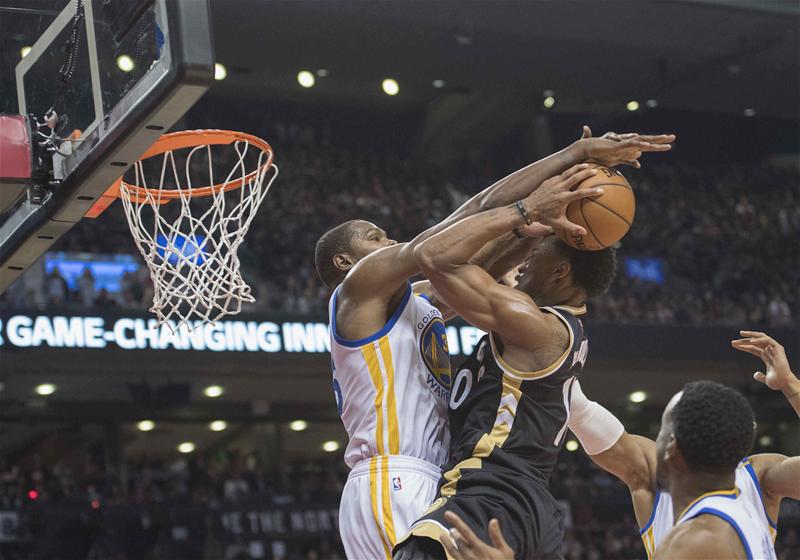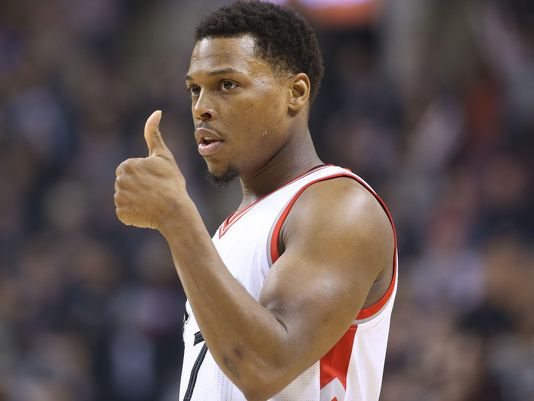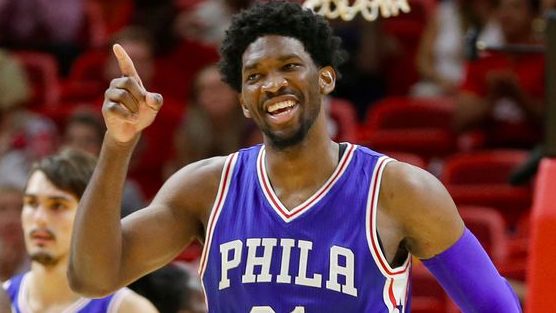The Toronto Raptors currently own the NBA’s top offense. Their 118.25 points per-100 possessions is not only ahead of the Golden State Warriors, it’s ahead of every other offense in the recorded turnover era. Seriously. It’s the best offense in recorded history right now, and the gap between the Raptors and the Warriors expands when controlling for schedule, per Basketball Reference‘s adjusted metrics (those same metrics have the Raptors as the league’s No. 1 team overall).
That the Raptors are performing at this level is impossible to question. It’s happened. Those statistics are descriptive. Whether or not it’s sustainable, though, is another question entirely. It’s a question that head coach Dwane Casey deflected immediately to the defensive side of the ball, because that’s just what Casey does, to the point that it’s become a bit of a running joke around the team.
“I know defense is sustainable, I do know that,” Casey answered ahead of Monday’s game. “But I’ll take the offensive explosion that we’re having right now and the good shooting, ball movement or whatever it is…But again is that sustainable. I do know defense travels, that is sustainable if you have your same defensive approach and defensive principles and togetherness on the defensive end.”
The answer, by the way, is almost surely “no,” because the most likely outcome as to whether any record-setting pace is sustainable is “no.” Regression is a powerful force, and while every high-water mark that exists at one time looked unsustainable, there’s a feeling that the Raptors don’t look like an elite offense. At least not compared to the Warriors.
Asked about that difference Monday, Casey went to one of his standby quotes.
“I’ve always said that, there’s a million different ways to skin a cat,” he said. “It is a good example of sometimes analytics don’t tell the whole story. It gives you a hint but it doesn’t tell you the whole story. If you can explain to me how we can shoot the ball and score as well as Golden State, that would be a good essay for you.”
This is not that essay, necessarily, but it’s something I wanted to address.
The Raptors’ succeeding says nothing about the use or value of analytics (really, we’re not talking about any deep “analytics” here, just fairly basic statistics with improved context, but the people love buzzwords). While it is true that the Raptors get a low percentage of their points from the restricted area and the 3-point line, those are not the only “analytic” principles good offenses are supposed to thrive on. You could perhaps call the Raptors’ offense anti-Moreyball (Houston Rockets’ general manager Daryl Morey is the namesake for pushing shot volume in those two areas, the most efficient spots on the floor, along with the free-throw line), and it would be true, but that would ignore some of the things they do very well.
Before looking at the shot mix, let’s take a step back and look at what goes into a full possession, using the “Four Factors.” We’re going to use the Warriors as a comparison point, since that’s the logical point of reference, given they’re the sexier offense (excluding Klay Thompson’s goatee). We’re also going to simplify a bit for the sake of illustration.
Factor 1 1: Turnover
The worst way a possession can end is with a turnover. While some teams absolutely accept turnovers as the cost of a more creative, pass-happy offense, it’s the least desirable outcome for any possession. The expected point value is 0, and opponents score more off of live turnovers than they do off of made field goals.
The Raptors rarely turn the ball over, a strength of this offense for years. With a 12.4-percent turnover rate, the Raptors cough up fewer possessions than all but two other teams. There’s a trade-off at play, to be sure – the Raptors are 29th in total passes made, 29th in potential assists, and 22nd in assist points created. The Warriors, meanwhile, pass the ball 40 more times per-game than the Raptors, grading as roughly average with a 14.3-percent turnover rate.
So one key thing the Raptors do well is protect the ball. 87.6 percent of their possessions result in a field-goal attempt, compared to just 85.7 percent for the Warriors. The Raptors have a bit of a cushion here to make less of the shooting possessions they do get, because they’re getting more shooting possessions than almost anyone else.
“Getting attempts, that’s the most important thing,” Casey said.
Factor 2: Effectiveness shooting the ball
This is the most obvious element of any offense. Make the shots you do take. And if you shoot them at the rim and from the 3-point line, even better. It’s also, I think, where the Raptors get the misnomer of not being a stats-friendly team, because they rank 25th in percentage of field-goal attempts that come in the “Moreyball” areas and 25th in the percentage of points that come from that area. (The Rockets are, not surprisingly, first by a long shot in the latter, while the Warriors are sixth.)
It’s true that the Raptors don’t shoot a lot of threes. They rank 23rd in total 3-point attempts and 20th in the percentage of field-goal attempts that come from behind the arc. That’s the nature of their offense. They are, however, hitting threes at a better rate than any other team in the NBA, canning 40.2 percent of their long-range attempts, enough to make them 12th in total makes despite their low frequency and slower pace. To contrast, the Warriors are second in both total makes and attempts, fourth in percentage of shots they take from long-range, and fourth in 3-point percentage at 38.1. They are a 3-point shooting team no matter how you slice it, whereas the Raptors are lethal with a lower usage.
In terms of shots inside the 3-point line, the Raptors are making the most of their suboptimal shot mix. They’re 25th in percentage of shots in the restricted area but seventh in making those shots. They’re 10th in percentage of shots from mid-range, the area of the floor DeMar DeRozan excels in but one that’s less efficient than anywhere else on the floor, and the Raptors are only slightly above-average (12th) at those shots as a whole. The one element of the Raptors’ shot mix that really stands out is that they shoot more shots from the non-restricted area of the paint than all but two other teams, and they’re better at those shots than anyone but Chicago (shout out to DeRozan’s floater).
You’d like to see the Raptors push some of those paint shots into the restricted area and you’d definitely like to see some of those mid-range looks moved into the paint or behind the arc, but this is how they’re built. The result is the fourth-best effective field-goal percentage, which controls for the additional value of threes, in the NBA. The Warriors are tops in that measure, owing to their high volume of threes, how lethal they are on the few mid-range shots they do take, and the fact that no team shoots better at the rim (and it is such a laughable gap – the Warriors shoot 69 percent in the restricted area, while the next best team shoots 63.8 percent).
The Warriors are also tops in the league in the percentage of field goals made that are assisted, while the Raptors are close to dead last. That’s a byproduct of Toronto’s low-pass attack and an offense designed to get their two best players in mismatches to attack, and so far it’s tough to argue with the results. It also leads to the third factor we’ll touch on in a second.
Of all of the elements of Toronto’s hot start, though, this is the one that feels the least sustainable. The Raptors always projected as an above-average 3-point shooting team by percentage, even with their cold start – Kyle Lowry, DeMarre Carroll, Terrence Ross, and Patrick Patterson are all average or better for their position, and it’s probably time to take Norman Powell seriously as a threat – but 40 percent at the team level is perhaps a little extreme (the Warriors were the only team to shoot better than 37.5 percent last year, at 41.6). They should grade as above-average in effective field-goal percentage, especially if the volume of threes creeps up, but they might not wind up top five.
So, to recap so far: The Raptors get to shoot on more of their possessions than almost anyone else, and they’re very good, though not quite Warriors-esque, at producing points when they shoot.
Factor 3: Getting to the line
It is hardly the most aesthetically pleasing way to score points, but there are few places more efficient to shoot than the free-throw line. The Raptors are loaded with strong free-throw shooters, ranking first in the league with an 81.8-percent mark from the stripe, so a possession that ends in a trip to the line is more valuable to them than many other teams. The Raptors’ effective field goal percentage means they average 1.068 points on every shooting possession, but two shots at the line have an average yield of 1.636 points (and that’s before controlling for the benefit of getting an opponent into foul trouble and/or getting into the bonus).
And there’s almost no team better at drawing fouls than the Raptors, who rank third in free-throw rate, taking .304 free-throw attempts for every field-goal attempt. It isn’t new, either, as the Raptors were even more extreme (but still ranked third) last year. It makes sense, because DeRozan may be the best player in the NBA at drawing contact outside of James Harden, and he’s the focal point of the offense. Lucas Nogueira has also become a foul-magnet, Jonas Valanciunas gets hacked inside plenty, Powell’s attacking off the catch often leads him to the line, and Lowry’s array of tricks, step-backs, and hard-line drives make him a dangerous complement to DeRozan’s own attacking. Most of the Raptors’ ball-handlers are adept at getting fouled, their role players can at least attack off the catch, their bigs are decent-to-good free-throw shooters, and even the contact-phobic Ross has a career-high free-throw rate right now.
Despite all of their immense talent, the Warriors are only 13th in free-throw rate. You can’t foul what you can’t catch, it turns out. The Warriors still hit a lot of free throws by nature of playing at a break-neck pace, and the Clippers are just as good as the Raptors at getting to the line, but Toronto’s combination of drawing fouls and hitting free throws has long been the biggest, quietest, and ugliest weapon in their offensive arsenal.
So, to recap so far: The Raptors get to shoot on more of their possessions than almost anyone else, they’re good at producing points when they shoot, and they draw fouls more than anyone else.
Factor 4: Offensive Rebound
Similar to turnovers, offensive rebounding goes a little unappreciated in determining offensive potential based on aesthetics. If limiting turnovers is the best way to maximize the number of shooting possessions you have, offensive rebounds are the best way to get additional ones. (Technically, an offensive rebound is not a “new” possession statistically. It is in spirit, but if you prefer to call it “extending” a possession, that’s probably the more statistically accurate terminology.)
The Raptors rank seventh in offensive-rebounding rate, grabbing 25.9 percent of their own misses. The Warriors, meanwhile, haul in 22.4 percent of those. This is pretty straight-forward. Chasing offensive rebounds comes with an opportunity cost in the form of transition defense, but they also create additional shooting opportunities. So once again, while the Warriors do more with their shooting possessions, the Raptors give themselves more opportunities to shoot. In fact, only Chicago has a higher rate of offensive rebounds less turnovers than Toronto.
So, to recap: The Raptors get to shoot on more of their possessions than almost anyone else, they’re good at producing points when they shoot, they draw fouls more than anyone else, and the rare times they don’t produce points, they’re above-average at extending possessions for another chance at scoring.
Offensive Efficiency
There’s more than just passing and shooting that goes into offensive efficiency. Those are the most obvious, and making shots is the most important, as Casey would surely remind you (“Make or miss league” is the name of his mixtape). The Raptors maximize their possessions better than almost anyone else, making sure they get more shooting possessions than almost anyone else, and making sure their focus is on getting to the line first and foremost. Even if their torrid shooting start slows down, doing all of these other things well gives the Raptors’ offense a pretty good floor, and it explains why the team knocking down threes feels so exponential at times.
So yes, there are a million ways to…you know what, let’s use a different metaphor…there are a lot of different ways to accumulate points in a basketball game. The Raptors have outperformed expectations in terms of scoring points on each shooting possession, an area they can’t match Golden State in. But they’ve also done a better job of maximizing their possessions in other ways, something this offense has been able to do for years. Regression would be natural from here, and the reasons Toronto was a top-five offense each of the last two years remain the same, conspiring to provide a pretty high floor in the event it hits.




